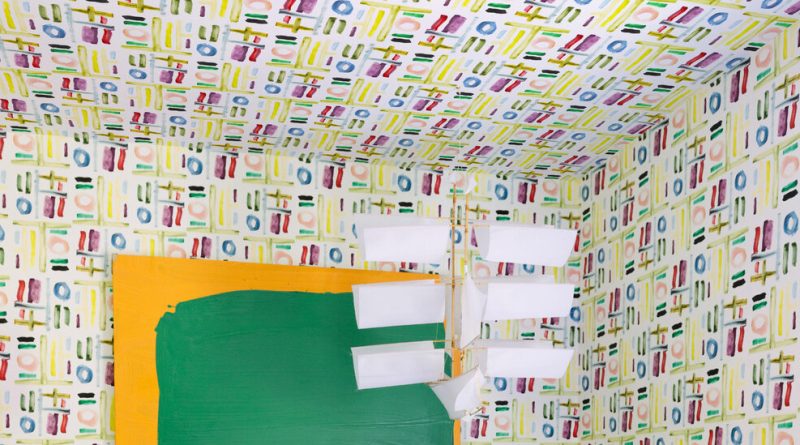Ceiling Wallpaper Makes a Maximalist Comeback
[ad_1]
When Ryia Jose decorated her daughters’ bedroom, she felt there was only one way to approach a room with a slanted ceiling: Cover it in wallpaper, the ceiling included.
Doing so helped “with all the weird angles,” said Ms. Jose, a D.I.Y.-er and interior decorator in Houston. “It adds to the quirkiness of it.”
Ms. Jose, 38, designed a custom pattern through the removable wallpaper brand Loomwell. It has a blush and green floral block print reminiscent of the patterns she grew up with in India.
Wallpaper has made its way back into homes in recent years as consumers continue eschew minimalist aesthetics in favor of maximalist décor. And now, wallpaper is climbing its way up to the ceiling not only in kids’ bedrooms but in home libraries and boutique hotel rooms, too.
It’s a shift from recent years, when many considered wallpaper cumbersome. When Jennifer Matthews helped found Tempaper in 2008, “no one wanted anything to do with wallpaper,” she said, because it was viewed as a costly — not to mention laborious and long-term — investment.
But pricing has become more competitive, and D.I.Y. jobs can cost less than $1,000. People have also caught on to how relatively low-stakes the decision can be thanks to peel-and-stick wallpaper. And so more customers are willing to use it in places they previously wouldn’t — like the ceiling. “You don’t feel like if you make a mistake, it’s permanent,” Ms. Matthews said.
In Atlanta, the interior designer Kristen Fountain Wilson uses peel-and-stick wallpaper and is drawn to “really graphic, bold papers.” Calling it “wallpaper” is almost a misnomer in her case — when she uses the product, it’s almost exclusively for ceilings. She said the ceiling gave it a place to “shine.”
Her clients are sometimes concerned that a wallpapered ceiling will make a room feel smaller, but Ms. Fountain Wilson said that botanical and floral wallpapers with light backgrounds had the opposite effect: “It opens the space up a little bit more,” she said.
Wallpaper on the ceiling can also create a mural-like effect. Kiki Slaughter, an artist in Richmond, Va., started selling wallpaper in September and discovered that people were drawn to her “painterly and abstract” wall coverings because they’re “literally art for your walls,” she said.
Her wallpapers come in a range of colors, including vibrant reds and soft pinks, and have names like “Scribble” or “Doodles,” describing Ms. Slaughter’s brushstrokes. “You can tell where my brushstrokes are,” Ms. Slaughter said. “It feels like I painted your wall or your ceiling.” She added that her most popular wallpaper for ceilings so far has been “Doodles” because it’s nondirectional and adds an extra dimension to the room.
Dwellers have tried to add this extra dimension though ceiling décor on and off throughout the centuries. Homes in the late 1800s might have had as many as five different wallpapers on the ceiling at onetime, said Bo Sullivan, an architectural historian and a founder of the antique wallpaper retailer Bolling & Company. The most elaborate ceilings might have a center fill, perimeter fill, a ceiling border, special corner pieces and maybe center medallion prints, too.
Intricate ceilings peaked during the Aesthetic Movement, which emerged from England in the late 1800s, he said. The movement was meant to be a departure from the stark ugliness of the Industrial Age. The houses of that era, even those of the middle class, were often decorated from top to bottom.
“The wallpaper was kind of like an outfit for the room,” said Mr. Sullivan, who lives in Portland, Ore. “And without a wallpaper, it’s a little bit naked.” Ceilings continued to be papered past the turn of the century, often with just one pattern, until the 1950s and the arrival of midcentury modernism.
Wallpaper used to be primarily about contributing to a space’s overall beauty. Brands like William Morris and Howell & Brothers produced wallpapers that were naturalistic and demure, featuring botanical and floral patterns.
“Now, it’s much more about statement making,” Mr. Sullivan said. “And in some cases, novelty.” Novelty has always played a role in wallpaper, he said, but, “as the beauty focus has gone down, the novelty and statement side has gone up.”
For Sasha Bikoff, an interior designer based in New York, her self-described “obsession” with covering every surface in a room began when she attended college in Paris in 2009. There, patterns and fabrics were used unabashedly on walls and ceilings; in the United States, she found, people will put a rug on the floor and decorate the walls but leave the ceiling bare.
“I always felt that in order to achieve really feeling like you’re in a jewel box, you had to think about all surfaces, meaning the floors, the ceilings and the walls,” said Ms. Bikoff, 35, who now lives in Manhattan.
She has put wallpaper on the ceilings of her residential and commercial projects, including the bathrooms of the recently opened Flex Mussels, a restaurant on the Upper East Side.
In a guest bedroom of her East Hampton home, Ms. Bikoff, wrapped the walls and ceiling in a wallpaper with a blue and white sea motif of starfish, seaweed and fish.
The idea is to lie down in bed and feel enveloped, Ms. Bikoff said: “You feel like you’re in a cocoon.”
